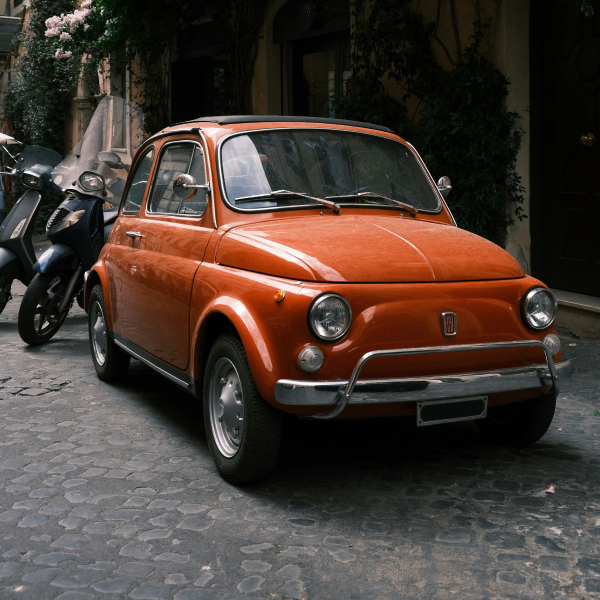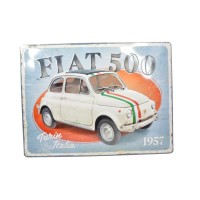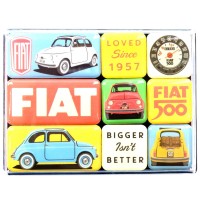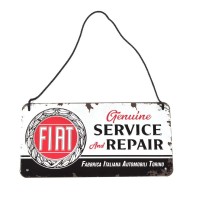The Fiat 500: History, Restoration Tips, and Essential Parts Guide
The Fiat 500, affectionately known as the "Cinquecento," was first introduced in 1957 by Fiat’s visionary engineer Dante Giacosa. Designed as a compact, affordable car, the Fiat 500 was envisioned to bring mobility to the masses and symbolize the spirit of Italian innovation. With its minimalistic design, 479 cc two-cylinder engine, and iconic rounded shape, the 500 became an instant classic. Fiat continued to innovate, evolving the model through various iterations, from the basic Nuova to the sportier 500 Abarth, each reflecting the zeitgeist of its era.
By the 1970s, the Fiat 500 was recognized worldwide as a symbol of practicality and charm. Its enduring popularity has made it a staple in classic car circles, where enthusiasts admire not only its history but its accessibility, both in terms of style and upkeep.
Key Features and Models of the Fiat 500
The Fiat 500’s longevity owes much to its simplicity and versatility. Throughout its production run, Fiat introduced several variations, each with unique features:
- Nuova (1957-1960): The original 500, known for its small yet efficient engine, featured a soft top and minimalistic interiors, designed for economy and ease of repair.
- 500 D and F (1960s): Larger engines, stronger bumpers, and more robust bodywork. The F model was a particular favorite, with its fully-opening doors.
- 500 L (Lusso) (1968-1972): Known for its upgraded interior with more luxurious finishes, chrome accents, and slightly higher ride.
- 500 R (Rinnovata) (1972-1975): The final iteration with a more powerful engine and updated mechanics, but without compromising the car’s signature look and feel.
Technical Highlights
The Fiat 500 is renowned for its simplicity, yet it offered surprising innovation for its time. Key highlights include:
- Engine Options: The Fiat 500 had an air-cooled two-cylinder engine, starting at 479 cc with 13 hp, which increased in later models.
- Economy and Practicality: With its lightweight build, compact size, and economical fuel consumption, the Fiat 500 was a pioneer of city-friendly design.
- Convertible Top: Many Fiat 500s featured a retractable roof, adding a unique touch of open-air driving fun.
Restoring and Maintaining a Fiat 500
Restoring a Fiat 500 allows enthusiasts to combine passion for Italian craftsmanship with an enjoyable hobby. Given the popularity of this classic, there’s a rich market for Fiat 500 parts and accessories. Common restoration projects include:
- Sheet Metal Parts: Essential for addressing common rust-prone areas, such as the wheel arches, sills, and floor pans.
- Interior Components: Carpeting, seats, and trim pieces that restore the original charm.
- Engine and Exhaust System: Regular maintenance or replacement of engine parts ensures reliability and improved performance.
Each part can be carefully chosen to either maintain the car's authenticity or incorporate subtle modern upgrades for a blend of vintage style and contemporary performance.
Must-Have Spare Parts and Accessories for Your Fiat 500
Whether you're in the midst of a full restoration or simple upkeep, the following parts can elevate the quality and experience of owning a Fiat 500:
- Body Panels: Quality sheet metal parts, bumpers, doors, and trunk panels are essential for maintaining the structural integrity and aesthetic appeal.
- Soft Top Roof: Many Fiat 500s come with a retractable roof; replacing or restoring this soft top maintains the car’s unique convertible feature.
- Interior Trim and Carpeting: From the dashboard instruments to seat upholstery and carpeting, interior parts restore the charm of the classic cabin.
- Cooling and Heating Systems: To ensure comfort and reliability, upgrading the cooling system and heater can make your 500 more enjoyable in all seasons.
- Engine and Ignition Parts: From distributor caps to spark plugs, keeping the engine tuned is vital for classic cars, enhancing both performance and longevity.
Maintaining Your Fiat 500 for the Road Ahead
Regular maintenance and care are essential to keep a classic Fiat 500 in top shape. Key tips include:
- Rust Prevention: Regular inspections for rust on the undercarriage, wheel arches, and doors can save considerable restoration costs.
- Engine Care: Routine oil changes, filter checks, and ignition maintenance keep the engine running smoothly.
- Brake and Suspension: Regular inspection of brake lines, front and rear axles, and clutch systems ensures safer and smoother handling.
- Winter Storage: If you live in a colder climate, storing your Fiat 500 during the winter months in a dry, covered space can help preserve the body and interior.
Find the Right Parts for Your Fiat 500
From full restorations to simple upkeep, having the right parts makes all the difference. Click below to explore our selection of Fiat 500 parts and accessories:
Conclusion
Owning a Fiat 500 is a joyful dive into a world of heritage, craftsmanship, and nostalgia. Each time you take the wheel, there’s a sense of stepping back into an era of classic motoring, whether you're winding through quiet streets on a sunny afternoon or proudly displaying your vehicle at a car show. The Fiat 500 is a symbol of Italian style and spirit, blending simple beauty with a lasting appeal that captures the hearts of enthusiasts around the world.
Maintaining and restoring a Fiat 500 brings a sense of fulfillment that goes beyond simple mechanics—it’s about carefully preserving a piece of automotive history. Every part replaced, every adjustment made, and every upgrade enhances its charm and reliability, connecting you with its storied past. With our comprehensive range of classic Fiat 500 parts—from interiors to body components—we’re here to support your journey, ensuring your Fiat 500 remains a treasured companion for years to come.









